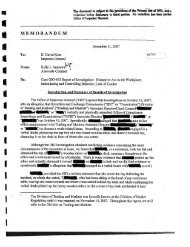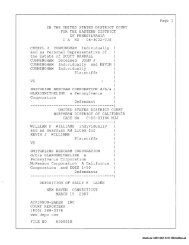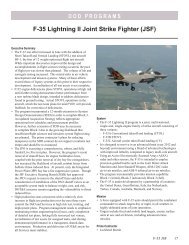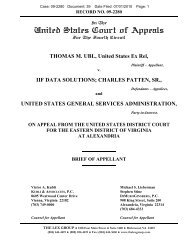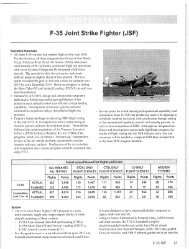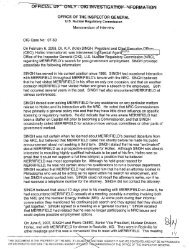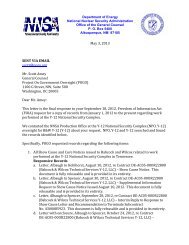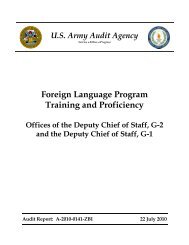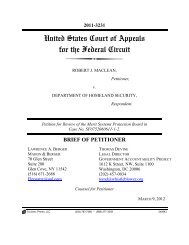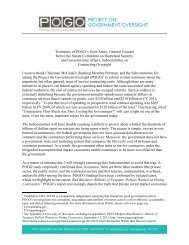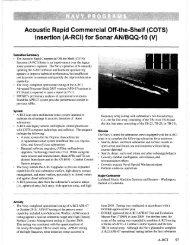F-35 Joint Strike Fighter (JSF)
F-35 Joint Strike Fighter (JSF)
F-35 Joint Strike Fighter (JSF)
You also want an ePaper? Increase the reach of your titles
YUMPU automatically turns print PDFs into web optimized ePapers that Google loves.
Mission<br />
<strong>Joint</strong> Force Commandersill w... use selected NCES services<br />
to enable shared understanding. interface with other<br />
decision-makers, orient forces, assess the situation, and/or<br />
synchronize operations-<br />
Activity<br />
• The <strong>Joint</strong> Interoperability Test Command (J ITC) led a<br />
multi-Service operational test team that conducted a series of<br />
FOT&E II events on a subset of NCES Increment I services<br />
from November 2009 through July 2010. The FOT&E AI was<br />
conducted in accordance with the DOT&E-approved Test and<br />
Evaluation Master Plan and operational test plan- However,<br />
testing of some services (ESM and Machine-to-Machine<br />
Messaging) relied heavily on pilot programs and<br />
demonstrations providing less confidence in the results-<br />
Services tested include the following:<br />
- Enterprise File Delivery<br />
- Enterprise Search<br />
- ESM<br />
Machine-to-Machine Messaging<br />
People Discovery<br />
Service Discovery<br />
• The Milestone Decision Authority authorized full deployment<br />
for Service Discovery on February 12, 2010, and made a<br />
fielding decision for Enterprise File Delivery, Enterprise<br />
Search, ESM- Machine-to-Machine Messaging, and People<br />
Discovery on September 20, 2010-<br />
• The test team conducted an IA assessment for a subset of the<br />
NCES services hosted at the DECCs. These assessments<br />
included IA documentation reviews, interviews with program<br />
office and hosting site personnel, penetration testing, and<br />
special events to assess restoration, failover, and incident<br />
response.<br />
• The test team plans to conduct a continuous evaluation of the<br />
ESM service to assess how it performs as the number of users<br />
increase.<br />
Assessment<br />
• The FOT&E II events were adequate to assess the operational<br />
effectiveness and suitability of a subset of NCES- Immature<br />
procedures and processes and the absence of sufficient<br />
numbers of end users limited the ability of DOT&E to assess<br />
ESM and Service Discovery as operationally effective.<br />
During the FOT&E II events, testers encountered significant<br />
limitations. An extremely limited user base for many services<br />
precluded an assessment of scalability to the levels envisioned<br />
in the Capabilities Production Document for the DoD<br />
enterprise. In addition, inconsistent quality of data provided<br />
by the various Managed Service Providers precluded an<br />
assessment of suitability-<br />
36 NCES<br />
Major Contractor<br />
Government Integrator -- DISA<br />
The following is a synopsis of the results for each service<br />
evaluated during the FOT&E events:<br />
The Enterprise File Delivery Service successfully<br />
synchronizes content to Multiple consumers on the<br />
unclassified network and is operationally effective- It is<br />
considered operationally suitable with limitations. The<br />
SLA and documentation need improvement-<br />
Enterprise Search is assessed as operationally effective<br />
with limitations. Improvements were made in timeliness,<br />
relevance of results, methods for exposing information,<br />
and the number of content sources since the IOT&E<br />
in 2008. However, users did not find that the NCES<br />
Enterprise Search provided advantages over existing search<br />
tools- Enterprise Search is also assessed as operationally<br />
suitable with limitations- User documentation and support<br />
to content owners need improvement-<br />
DOT&E was unable to determine the operational<br />
effectiveness of ESM due to the low level of use (only<br />
one of three monitoring agents was used during the test)<br />
and because a majority of services being monitored were<br />
not being used in an operational context. Users report<br />
ESM provides a needed capability to optimize software<br />
performance and provide them situational awareness<br />
for distributed software services- More guidance from<br />
DoD CIO and USD (AT&L) is needed to enable software<br />
service integrators to select and configure appropriate ESM<br />
capabilities. Also further testing should be conducted<br />
in which ESM provides situational awareness and<br />
management of operational services. ESM is considered<br />
to be operationally suitable due to its ease of use and good<br />
help desk support.<br />
Machine-to-Machine Messaging is rated as operationally<br />
effective and operationally suitable with limitations. Users<br />
reported the service performs the required functions, but<br />
the users had problems troubleshooting faults, configuring<br />
security devices, and monitoring service health and status,<br />
and were not notified of upgrades or outages- With the<br />
suspension of key pilot programs and demonstrations, no<br />
new programs have committed to use Machine-to-Machine<br />
Messaging. Users report a preference for another DISA<br />
service, the <strong>Joint</strong> User Messaging Service. Since the<br />
DOT&E report, Machine-to-Machine Messaging has been<br />
integrated with a new Program of Record and the Program<br />
Office is currently working with several potential users.



